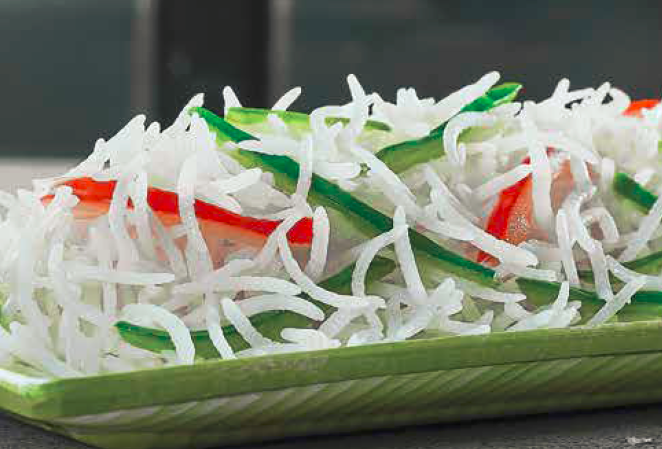
Rice is a staple in any kitchen, and with so many different types, it lends itself to a limitless number of recipes. Before you add the same type of rice to every recipe you prepare, however, think twice. Substituting one type of rice for another can really alter the result of a recipe. Each type of rice has its own taste, texture, and unique properties that work well with different cooking applications. So how do you know which one is the best type of rice to use? This guide examines factors that differentiate types of rice, from nutty basmati to fragrant jasmine and more!
Glossary
The following anatomy terms may be used throughout this guide when discussing the differences in types of rice.
-
Hull – Each grain of rice is enclosed in a tough outer hull, or husk, that needs to be removed before it can be consumed. This layer is removed in all rice types.
-
Bran – Under the hull, the bran layer is not removed in all rice types. This nutritious whole grain section is usually tan-colored, but it may be reddish or black depending on the pigmentation in the bran layers. The bran layer may be consumed, but it is often removed when further processing rice.
-
White Rice – Once the bran and germ layers are removed, white rice remains. Known as the endosperm, this is the part of the rice that is most commonly consumed.
-
Germ – Found under the hull, the germ, or rice kernel, is nutrient-dense. Full of B vitamins, minerals, and proteins, it helps give rice its color and added nutritional benefits.
Type Of Rice
-
Rice is often characterized as one of three varieties – long grain, medium grain, or short grain rice. These varieties refer to the length and shape of the grain. Simply speaking, long grain rice will have a longer cylindrical shape, whereas short grain rice will be shorter and wider.
-
Long Grain Rice – This rice has milled grains that are at least three to four times as long as they are wide. Due to its starch composition, it is separate, light and fluffy when cooked.
-
Medium Grain Rice – When compared to long grain rice, medium grain rice has a shorter, wider kernel. Since the cooked grains are more moist and tender than long grain rice, the rice has a greater tendency to stick together.
-
Short Grain Rice – Featuring grains that are less than twice as long as they are wide, this rice is short and best for sushi. It has a sticky texture when cooked.
-
When cooking rice dishes, you’ll want to think about the desired texture of the rice. The starch content varies from rice type to rice type. It will affect whether rice is sticky or light and fluffy.
-
Sticky Rice – Also known as sweet rice, sticky rice is grown mainly in Southeast and East Asia and is used in many traditional Asian dishes, desserts, and sweets. When cooked, sticky rice is especially sticky and is often ground into rice flour.
-
Parboiled Rice – This “rough” rice has gone through a steam-pressure process before milling that gelatinizes the starch in the grain. This process produces a more separate grain that is light and fluffy when cooked. Converted rice is a type of parboiled rice that has been further pre-cooked, which ultimately allows you to whip up dishes of rice even faster.
-
Rice is naturally brown after harvesting, but once the nutrient-rich outer layer of bran is removed, it is white in color. Red rice, black rice, and purple rice all feature unique pigmentation in the bran. For these colorful rice varieties, the bran layer usually remains for added visual appeal and added nutritional value.
-
Polished Rice – The term “polished” simply refers to white rice that has had its outer brown layer of bran and germ removed. Rice that has shed its bran layers can also be referred to as “milled rice.”
-
Brown Rice – This healthful rice sheds its outer husk and retains its bran and germ layers that give it a characteristic tan color. Though brown rice takes a little longer to cook than white rice, the nutrient-dense layers are rich in vitamins and minerals.
-
Forbidden Rice – High in nutritional value, this rice is also known as black rice and has a mild nutty flavor. Slightly sticky when cooked, it is used in a variety of Chinese or Thai dishes, including Chinese black rice cake and mango sticky rice. Mix it with white rice, and it also adds color to any rice pilaf or rice bowl.
-
Wild Rice – Wild rice grains are harvested from the genus Zizania of grasses. High in protein, wild rice adds a colorful, exotic flair to any rice dish. Serve it with stir frys, mushroom soups, or casseroles for something new.
-
Aroma is another factor to consider when cooking with rice. Certain rice varieties give off pleasing fragrances while being cooked. Add a sensory element to your guests’ dining experience with these rice types.
-
Basmati Rice – Basmati rice is a type of long-grain rice that is popular among Indian cuisine and other ethnic dishes. Cooked basmati rice imparts a subtle nutty or popcorn-like flavor and aroma.
-
Jasmine Rice – Jasmine rice, sometimes known as Thai fragrant rice, is a type of long grain rice with a long kernel and slightly sticky texture when cooked. Use it to infuse a subtle jasmine flavor and aroma into your dishes.
Length and Shape
Texture
Color
Aroma

Jasmine Rice
White Rice
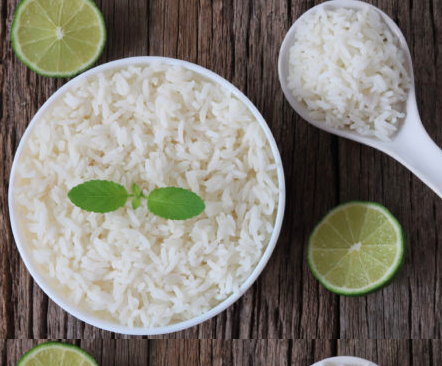
White rice is milled rice that has had its husk, bran, and germ removed. This alters the flavor, texture and appearance of the rice and helps prevent spoilage and extend its storage life. After milling, the rice is polished, resulting in a seed with a bright, white, shiny appearance.
The milling and polishing processes both remove nutrients. A diet based on unenriched white rice leaves many people vulnerable to the neurological disease beriberi, due to a deficiency of thiamine (vitamin B1). White rice is often enriched with some of the nutrients stripped from it during its processing. Enrichment of white rice with B1, B3, and iron is required by law in the United States. As with all natural foods, the precise nutritional composition of rice varies slightly depending on the variety, soil conditions, environmental conditions and types of fertilizers.
Adopted over brown rice in the second half of the 19th century because it was favored by traders, white rice has led to a beriberi epidemic in Asia.
At various times, starting in the 19th century, brown rice and wild rice have been advocated as more healthful alternatives. The bran in brown rice contains significant dietary fiber and the germ contains many vitamins and minerals.
Typically, 100 grams of uncooked rice produces around 240 to 260 grams of cooked grains, the difference in weight being due to absorbed cooking water.
Brown Jasmine Rice
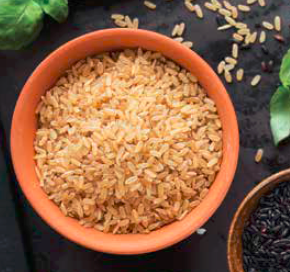
Brown rice is a whole-grain rice with the inedible outer hull removed. This is as compared with white rice, which is the same grain, also with hull removed, but also with the bran layer and cereal germ removed. Red rice, gold rice, and black rice are all whole rices, but with differently pigmented outer layers.

Basmathi Rice
Basmati is a variety of long, slender-grained aromatic rice which is traditionally from the Indian subcontinent.

According to the Indian Government agency APEDA, a rice variety is eligible to be notified as Basmati if it has a minimum average precooked milled rice length of 6.61 mm and average precooked milled rice breadth of up to 2 mm, among other parameters.
Aroma and flavor
Basmati rice has a typical pandan-like (Pandanus amaryllifolius leaf) flavor caused by the aroma compound 2-acetyl-1-pyrroline. Basmati grains contain about 0.09 ppm of this aromatic chemical compound naturally, a level that is about 12 times more than non-basmati rice varieties, giving basmati its distinctive spicy fragrance and flavor. This natural aroma is also found in cheese, fruit and other cereals. It is a flavoring agent approved in the United States and Europe, and is used in bakery products for aroma.
During cooking, the level of 2-acetyl-1-pyrroline decreases. Soaking the rice for 30 minutes before cooking permits 20% shorter cooking times and preserves more of the 2-acetyl-1-pyrroline.
Glycemic index
According to the Canadian Diabetes Association, basmati, brown, wild, short and long grain rice has a “medium” glycemic index (between 56 and 69) opposed to jasmine and “instant” white rice with a glycemic index of 89, thus making it more suitable for diabetics as compared to certain other grains and products made from white flour.

Non Basmathi Rice
Parboiled rice (also called converted rice and easy-cook rice) is rice that has been partially boiled in the husk. The three basic steps of parboiling are soaking, steaming and drying. These steps make the rice easier to process by hand, while also boosting its nutritional profile, changing its texture, and making it more resistant to weevils. About 50% of the world’s paddy production is parboiled. The treatment is practiced in many parts of the world.
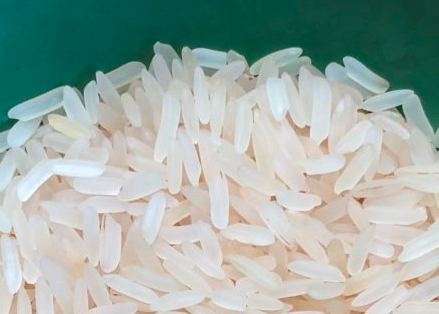
Rice is easier to polish by hand (removal of the bran layer) after parboiling but mechanical processing is harder since the bran becomes somewhat oily and tends to clog machinery. Most parboiled rice is milled in the same way as white rice.
Parboiling drives nutrients, especially thiamin, from the bran to the endosperm, hence parboiled white rice is mostly nutritionally similar to brown rice. Because of this, parboiling was adopted by North American rice growers in the early 20th century.
Process and chemistry
The starches in parboiled rice become gelatinized, then retrograded after cooling. Through gelatinization, amylose molecules leach out of the starch granule network and diffuse into the surrounding aqueous medium outside the granules which, when fully hydrated are at maximum viscosity. The parboiled rice kernels should be translucent when wholly gelatinized. Cooling brings retrogradation whereby amylose molecules re-associate with each other and form a tightly packed structure. This increases the formation of type 3-resistant starch which can act as a prebiotic and benefit good health in humans. However, this also makes the kernels harder and glassier. Parboiled rice takes less time to cook and is firmer and less sticky. In North America parboiled rice is either partially or fully precooked before sale. Minerals such as zinc or iron are added, increasing their potential bio-availability in the diet.
Huzenlaub Process
In older methods, clean paddy rice was soaked in cold water for 36–38 hours to give it a moisture content of 30–35%, after which the rice was put in parboiling equipment with fresh cold water and boiled until it began to split. The rice was then dried on woven mats, cooled and milled.
In the 1910s German-British scientist Erich Gustav Huzenlaub (1888–1964) and the British scientist and chemist Francis Heron Rogers invented a form of parboiling which held more of the nutrients in rice, now known as the Huzenlaub Process. The whole grain is vacuum dried, then steamed, followed by another vacuum drying and husking. This also makes the rice more resistant to weevils and lessens cooking time.
Modern methods
In even later methods the rice is soaked in hot water, then steamed for boiling which only takes three hours rather than the twenty hours of traditional methods. These methods also yield a yellowish color in the rice, which undergoes less breakage when milled.
Other variations on parboiling include high-pressure steaming and various ways of drying (dry-heat, vacuum, etc.)
Nutrition
Compared to brown rice, parboiling of rice incurs losses of thiamin, niacin, biotin, and pantothenic acid by approximately 70%, 28%, 49% and 25%, respectively. Compared to normal milling, which causes a near 65% loss of all these micronutrients, parboiling preserves more of them. The specific loss depend on the process used by individual manufacturers: for the USDA #20042 sample, much less loss in these nutrients is observed. Fortification is common for parboiled rice in the United States.

Long Grain Rice
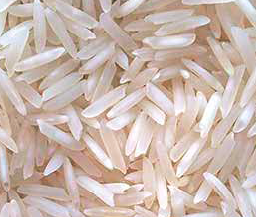 Long grain rice kernels are three times longer than they are wide what means that are more than 6 mm. When cooked, this grain is light and separates easily. There are as well gelatinous long grain rice in Thailand where are native. It contains much less niacin, thiamin, magnesium, zinc, iron and fiber than the brown rice. White rice may be covered with magnesium silicate or with a mixture consisting of talc and glucose which is also known as talc-coated rice. This type of rice is cultivated in India and Pakistan. Long-grain rice has the most amylose and the smallest amount of amylopectin, so it has a propensity to be the fluffiest and least sticky. Amylose also hardens more when is fresh, combination strongly together and farming crystals that melt when the rice is reheated. Rice that is high in amylose has a lower Glycerin index number. Amylopectin is a highly divided molecule that makes the rice humid when it’s released from the grain during cooking.
Long grain rice kernels are three times longer than they are wide what means that are more than 6 mm. When cooked, this grain is light and separates easily. There are as well gelatinous long grain rice in Thailand where are native. It contains much less niacin, thiamin, magnesium, zinc, iron and fiber than the brown rice. White rice may be covered with magnesium silicate or with a mixture consisting of talc and glucose which is also known as talc-coated rice. This type of rice is cultivated in India and Pakistan. Long-grain rice has the most amylose and the smallest amount of amylopectin, so it has a propensity to be the fluffiest and least sticky. Amylose also hardens more when is fresh, combination strongly together and farming crystals that melt when the rice is reheated. Rice that is high in amylose has a lower Glycerin index number. Amylopectin is a highly divided molecule that makes the rice humid when it’s released from the grain during cooking.

